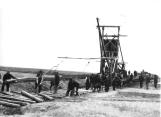1
It was the railway, specifically the Grand Trunk Pacific Railway, that initiated the creation of the town of Mirror.The Transcontinental Townsite Co. Ltd., the property agent the Grand Trunk turned the task over to, had a vision of a grand town and lakeside resort which would be the hub and trade centre to the heart of one of Alberta's richest agricultural areas.
Without this railway pushing it's way into the West, Mirror would never have come into existence.
Here is a bit of the history of the Railway and the GTP.
In 1890, rail lines began to be built between Edmonton and Calgary, and the track was leased to the C.P.R. (Canadian Pacific Railway).
Lacombe was the main station for settlers coming to the Buffalo Lake area to disembark. From here, to get to their final destinations, they looked forward to a rough journey by wagon of anywhere between 2 and 6 days, depending on the time of year and weather conditions.
In 1904, work began to extend the rail lines from Lacombe, to Stettler, later extending even further, into Saskatchewan.
By 1905, both Tees and Alix were connected, but the line did not yet extend into the Lamerton/Buffalo Lake area.
In 1910, the Grand Trunk Pacific Railway decided to get involved in the West, building a main line from Edmonton to Calgary, passing through the west Buffalo Lake country in the fall of 1910, and the spring of 1911.
The story of how the town of Mirror actually sprung up from here is found in section E, "The Auction".
See more on the Grand Trunk Pacific Railway's history at:
http://collections.ic.gc.ca/cnphoto/english/gtp3_ang.html
3
A 1910 railroad construction team, working near Mirror, Alberta. Most likely creating the rail line into the Mirror area.The picture shown is of a horse drawn "Elevating Grader" which performed the same role as today's "cat and scraper" or motorized Le Tourneau.
The "elevating grader" scraped up material from the ditches and placed it to form the sub-grade.
The majority of the prairie railway sub grades were prepared by "elevating graders" as opposed to the more labour intensive shovel and wheelbarrows used in earlier construction.
5
A good view of how large some of the railway construction crews could be in 1910.7
This is a photo of Jim Cairns on a Grand Trunk Pacific Railway construction crew, grading with another elevator grader.They are preparing the land for new Grand Trunk Pacific train tracks to be installed, most likely South or West of Mirror, towards Calgary.
This equipment was pulled by horses, and managed by the strength of the men of the day.
The Robert Cairns (Jim's dad) family was one of the very early families in our area, the second family in what eventually became the Gadsby Lake district.
Jim Cairns, was born on Prince Edward Island in 1890, and first came to the West with his family in 1892. His father took a homestead near Lacombe (45km West of Mirror).
The family returned to the East in 1893, returning to the West again in 1894 or 1895, where they settled this time near Lamerton, where there was more open range land for his cattle ranch.
Jim was a well-known hunter and sportsman, playing baseball and hockey at both Lamerton and Mirror.
He married Mabel Simpson on December 12, 1911, moving to the George district, close to Mirror, increasing his land to 911 acres, and farmed for many more years.
In 1923, Jim moved his family to Mirror so his children, Bob, Isabelle and Jean could attend school.
From 1918 to 1939, Jim ran the grader for the municipality He was part of the Municipal Council for several years around 1915, and was a member of Mirror's school board after moving to Mirror.
Jim still farmed his land until selling it to Mike Felt in 1949, and continued to live in Mirror until his death in 1970.
To this day, Jim's name and deeds are still well known in Mirror.
9
This is a typical small Grand Trunk Pacific railway camp, where they would rest, sleep and eat.Women would be the camp cooks and take care of the men.
This particular camp was North of Bashaw (approximately 10km NE of Mirror), and this crew was most likely working on the railway line going into Mirror, somewhere around 1910.
The three middle people are:
Mr. and Mrs. Kneebone and their daughter, Ethel (later Mrs. Wm. Rees).
Mrs. Kneebone was the camp cook.
11
This was the largest wooden Bridge in the world, and was situated on the Grand Trunk Pacific rail line, North of Mirror, where it crossed the Battle River. It was built in the early 1900's.It was a marvel of it's age, of any age for that matter.
An elder of our community, Mr. Brian Bellamy told us that the first train that travelled across it, broke a rail.
This bridge no longer exists, although, upon close inspection of the area, a few of it's foundation structures can still be found.
13
This is Mirror's Grand Trunk Pacific Railway Station in 1911. It was still in the process of being completed.This photo came from the front of a postcard, which was sent from Mirror, by Ethel Hoffman, to her Father, Ferdinand E. Hoffman, in Tees (about 13km W of Mirror).
This station burned down in the summer of 1975.






